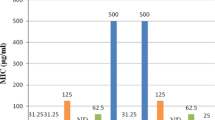Eight new substituted spiro-1,2,4,5-tetraoxane derivatives were synthesized and characterized by a number of analytical and spectroscopic techniques. The molecules were subsequently screened for in vitro antimalarial activity against chloroquine sensitive (3D7) and chloroquine resistant (RKL-9) strains of Plasmodium falciparum. These substituted spiro-1,2,4,5-tetraoxane derivatives were studied by molecular docking analysis in the active site of Falcipain-2 as a putative protein. Most of the synthesized compounds exhibited moderate to very good activity toward the parasite in comparison to the standard drug, chloroquine. Three compounds showed potent antimalarial activity against chloroquine sensitive strain of P. falciparum (3D7). One compound 5b (3-ethyl-3-methyl-1,2,4,5-tetraoxa-spiro[5.5]undecane) showed a very good activity against both chloroquine sensitive strain (3D7) with MIC = 1.95 ± 0.06 μg/mL and IC50 = 1.95 ± 0.06 μg/mL compared to chloroquine (MIC = 0.4 ± 0.10 μg/mL, IC50 = 0.04 ± 0.01 μg/mL) as well as chloroquine-resistant strain of P. falciparum (RKL-9) with MIC = 15.63 ± 0.70 μg/mL and IC50 = 3.90 ± 0.09 μg/mL compared to chloroquine (MIC = 25.00 ± 0.20 μg/mL, IC50 = 0.39 ± 0.02 μg/mL). The top scored compounds having low binding energy interact with the active site of Falcipain-2 in molecular docking studies.



Similar content being viewed by others
References
WHO: World Malaria Report 2013, ISBN 978 92 4 156469 4. www.who.int [accessed on 19.06.2014].
www.rbm.who.int [accessed on 05.02.2014].
M. K. Kumawat, P. Parida, and D. Chetia, Med. Chem. Res., 25(9), 1993 – 2004 (2016).
M. K. Kumawat and D. Chetia, Bangladesh J. Pharmacol., 10, 917 – 923 (2015).
M. K. Kumawat, U. P. Singh, B. Singh, et al., Arab J. Chem., 9, S643 – S647 (2016).
M. K. Kumawat, U. P. Singh, and D. Chetia, Pharm. Chem. J., 53(9), 822 – 830 (2019).
P. M. O’Neill, G. L. Ellis, R. Amewu, et al., Bioorg. Med. Chem. Lett., 18, 1720–1724 (2008).
P. M. O’Neill, G. L. Ellis, R. Amewu, et al., J. Med. Chem., 51(7), 2170–2177 (2008).
D. A. Casteel, in: Burger’s Medicinal Chemistry and Drug Discovery, 5th ed., Wiley Interscience: New York (1997), Vol. 5, pp 3 – 75.
N. Kumar, S. I. Khan, H. Atheaya, et al., Eur. J. Med. Chem., 46, 2816 – 2827 (2011).
N. Kumar, S. I. Khan, Beena, et al., Bioorg Med Chem., 17, 5632 – 5638 (2009).
N. Kumar, S. I. Khan, M. Sharma, et al., Bioorg Med Chem., 19, 1675 – 1677 (2009).
P. M. O’Neill, R. K. Amewu, G. L. Nixon, et al., Angew. Chem. Int. Ed., 49, 5693 – 5697 (2010).
J. Coates, in: Encyclopedia of Analytical Chemistry, R. A. Meyers (Ed.). John Wiley & Sons: Chichester (2000), pp. 10815 – 10837.
D. W. Mathieson, Interpretation of Organic Spectra, Academic Press, New York (1965).
D. J. Pasto, C. R. Johnson, M. J. Miller, Experiments and Techniques in Organic Chemistry, Prentice Hall: New Jersey (1992).
R. M. Silverstein and F. X. Webster, Spectrometric Identification of Organic Compounds, John Wiley & Sons: New York (1963).
A. O. Terent’ev, D. A. Borisov, and I. A. Yaremenko, Chem. Heterocycl. Compd., 48(1), 55 – 58 (2012).
I. Opsenica, D. Opsenica, K. S. Smith, et al., J. Med. Chem., 51, 2261 – 2266 (2008).
D. Opsenica, D. E. Kyle, W. K. Milhous, et al., J. Serb. Chem. Soc., 68(4–5), 291 – 302 (2003).
K. K. Kamboj, Central Drug Research Institute, Lucknow (2006), pp. 184 – 198.
W. Trager and J. B. Jensen, Science, 193, 673 – 675 (1976).
R. Oliveira, A. S. Newton, R. C. Guedes, et al., Chem. Med. Chem., 8, 1528 – 1536 (2013).
Y. Liu, W. Q. Lu, K. Q. Cui, et al., Arch. Pharm. Res., 35(9), 1525 – 1531 (2012).
Acknowledgements
The authors are thankful to Dr. C. R. Pillai, Emeritus Scientist, and Dr. Anup Anvikar, Director, National Institute of Malaria Research (Indian Council of Medical Research, New Delhi) for providing antimalarial screening facilities and training. The authors also are thankful to S. A. I. F., Punjab University (Chandigarh, India) for providing spectroscopic data.
Conflict of Interest
The authors declare that they have no conflicts of interest.
Author information
Authors and Affiliations
Corresponding author
Rights and permissions
About this article
Cite this article
Kumawat, M.K., Chetia, D. Synthesis, Antimalarial Activity Evaluation and Molecular Docking Studies of Some New Substituted Spiro-1,2,4,5-Tetraoxane Derivatives. Pharm Chem J 55, 814–820 (2021). https://doi.org/10.1007/s11094-021-02500-2
Received:
Published:
Issue Date:
DOI: https://doi.org/10.1007/s11094-021-02500-2




